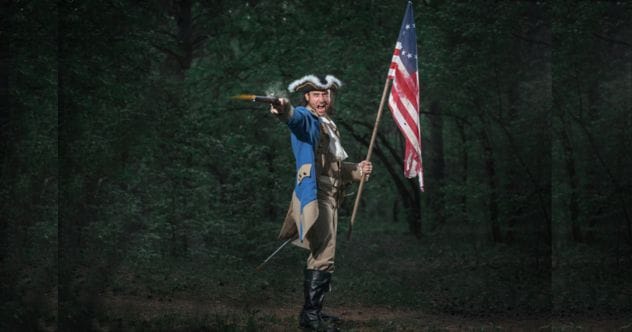The American Revolution is filled with famous heroes. Names like Molly Pitcher, Paul Revere, and Nathan Hale are still well-known today. However, many other people made important contributions to America’s fight for independence. Sadly, history has mostly forgotten these heroes. While people still remember names like Lafayette, countless others have been unfairly left out. They deserve our recognition.
The Revolution would not have been won without the brave actions of many people, including the ten in this list. They risked their lives and fortunes to help America gain freedom from the British Empire. Most Americans don’t know about their efforts and sacrifices. It’s important to honor these forgotten heroes of the American Revolution. They fought for freedom and helped the cause without fail. Without these ten, the United States might be very different today—or might not even exist.
10 Seth Warner
During the time before the Revolution, Vermont was called the Hampshire Grants. Both New York and New Hampshire claimed it. But the people wanted to be independent from both colonies. So, they formed the Green Mountain Boys. These men, who wanted independence, were led by Ethan Allen and Seth Warner. Both were well-known in the area and stood up against the authorities, especially those from New York.
Ethan Allen became famous for capturing Fort Ticonderoga from the British in 1775. Seth Warner didn’t get as much recognition, but he still played a vital role in the American Revolution. He fought alongside John Stark and Benedict Arnold in the Saratoga Campaign after being involved in the Canadian invasion. There, he greatly helped the Patriots win at Bennington. Even though New York had outlawed him for his earlier actions with the Green Mountain Boys, Warner remained dedicated to the patriotic cause.
After the war, Allen’s political career became more prominent than Warner’s influence in Vermont. Warner’s health got worse because of his many military campaigns. He died at only 41 years old in 1784. Since then, people have remembered Ethan Allen’s contributions to the American Revolution more than Warner’s. This has made Warner relatively unknown outside of Vermont. Still, Vermont wouldn’t have been as strong during the Revolution without Seth Warner. And the northeastern colonies might not have been able to defeat the British without his bravery.[1]
9 Thomas Sumter
In the 2000 movie The Patriot, Mel Gibson plays Benjamin Martin. He was a planter and guerrilla fighter inspired by Francis Marion, also known as the Swamp Fox. But Marion wasn’t the only guerrilla fighter from South Carolina in the Revolutionary War. Thomas Sumter was another fierce fighter from the state who is less well-known. Sumter was also a model for Martin’s character. Like Martin, the British burned Sumter’s plantation in the High Santee region. After that, he led irregular forces in a campaign against the British. And because of this, almost his entire command was destroyed.
Sumter got the nickname “Carolina Gamecock” after a fight with British Colonel Banastre Tarleton’s troops at the Battle of Blackstock’s Farm. Tarleton told Lord Cornwallis that Sumter fought with the ferocity of a gamecock. Even though the battle was small, it was part of a series of American actions to disrupt British communication and supply lines in the Carolinas.
Soon, Sumter’s constant harassment of Cornwallis earned him the title of the British commander’s “greatest plague” in the Deep South. After the war, Sumter went into politics. He served in the U.S. House of Representatives and the Senate until he resigned in 1810. Despite being quite famous during his life, Sumter’s personality often alienated even his friends. This led to his declining reputation after his death. But he lived longer than all the other generals from the American Revolution, finally dying in 1832. Fort Sumter, where the American Civil War later began, was named in his honor after his death.[2]
8 John Stark
John Stark was a member of Rogers’ Rangers during the French and Indian War. During that time, he didn’t like the “gentlemen” officers in the British Army. After the war, he became a farmer in New Hampshire. When he heard about the fighting in Lexington and Concord on April 23, 1775, he rejoined the militia as a colonel. By early June, Stark and his regiment were part of the Continental Army surrounding Boston.
Stark’s group played a crucial role in the Battle of Bunker Hill. They served as the rear guard during a key American retreat. He also participated in the siege of Boston, the unsuccessful invasion of Canada, and the Battles of Trenton and Princeton. After Princeton, he went back to New Hampshire to recruit more troops for Washington’s army.
However, political issues over promotion led him to resign. But his service wasn’t over yet. When British General John Burgoyne and his Indian allies came from Canada into upstate New York, Stark returned to duty. He commanded troops from New Hampshire and other Continental soldiers during the Saratoga Campaign. One of his notable achievements was leading the American forces to victory in the Battle of Bennington. They beat Burgoyne’s Hessian troops in a major win. That victory forced the British to stop their advance through Vermont. Stark continued to serve with the American Northern Army for the rest of the war.
Afterward, he went back to his farm in New Hampshire and became relatively unknown, though people remember his contributions today.[3]
7 Henry Dearborn
Henry Dearborn was a captain in the Revolutionary War and a well-known fighter. He led a New Hampshire militia in John Stark’s regiment. He fought bravely at Bunker Hill. He even joined Benedict Arnold’s invasion of Canada through the Maine wilderness. Dearborn’s detailed journals provide insight into the difficult military march during this campaign.
However, his journey took a turn when the British captured him during the assault on Quebec on New Year’s Eve in 1775. After being released in May of the following year, Dearborn rejoined the Continental Army. There, he participated in the Saratoga campaign and endured the hardships of Valley Forge.
Dearborn’s notable contributions continued from there. He appeared at major military skirmishes like Monmouth Courthouse. He also fought in John Sullivan’s expedition against the Iroquois. And he played a crucial role in the Yorktown Campaign. He was there for the surrender of British armies at both Saratoga and Yorktown.
His bravery earned him lasting recognition. Fort Dearborn in Detroit, Dearborn County in Indiana, and Fort Dearborn in Illinois are all named in his honor. Although his later military efforts during the War of 1812 were less impressive, Dearborn remained honorable. However, as time passed, his achievements in the American Revolution gradually faded from history books. By the mid-19th century, he was mostly forgotten, despite his later government service, where he was even appointed as Minister to Portugal in the 1820s.[4]
6 Lord Stirling
William Alexander, better known as Lord Stirling, was the son of a successful lawyer and businessman from New York. He embraced his Scottish heritage and claimed the title of the Earldom of Stirling. Although his father didn’t pursue the title, Scottish courts recognized William’s claim. Americans soon accepted it, even though the British House of Lords ignored it. His extravagant lifestyle, fueled by his desire to live like a peer, plunged him into debt.
When the Revolutionary War started, he went further into debt by forming and equipping his own regiment, the First New Jersey Regiment. During the Battle of Long Island, Lord Stirling’s regiment bravely held its ground against the British regulars, even though the Americans were defeated. This resulted in heavy casualties, but they stood strong against their foes. Lord Stirling was captured when his men were overwhelmed, but he wouldn’t be held for long.
After being exchanged, he rose to the rank of Major General. Soon, he played significant roles in crucial battles such as Trenton, Brandywine, Germantown, and Monmouth. Washington respected him highly and even entrusted him with command over the troops left behind in New York while the main army moved to Virginia and Yorktown in 1781.
Tragically, Lord Stirling died in Albany in January 1783, before the Revolutionary War ended. Despite his remarkable performance as one of Washington’s capable commanders, he remains largely unknown outside of New Jersey. In that state, his descendants have maintained his estate. His claim to the Scottish Earldom of Stirling died with him, and the title returned to obscurity as well.[5]
5 John Barry
John Barry was a shipmaster from Philadelphia who was called to play a vital role in the American Revolution. Although John Paul Jones is more famous, Barry’s services were important enough for the U.S. Navy to recognize him as one of its founding figures. Along with John Adams, Barry has been called the “Father of the United States Navy.” At just 21 years old, Barry, who was born in Ireland, pledged his loyalty to the Continental Congress. He quickly became a captain in their service, commanding the brig Lexington.
Throughout the war, Barry led various ships of the Continental Navy into battle. He also worked as a privateer between assignments. He captured many enemy vessels, stopped multiple mutinies, and mentored young officers who later achieved great success in the military. On March 10, 1783, he commanded the USS Alliance in the final battle of the American Revolutionary War.
He impressively repelled two British ships that had more armaments. The Captain of one of the British ships in the fight, HMS Sybil, acknowledged Barry’s exceptional leadership. The impressed Brit later stated publicly that he had never seen a ship fought as skillfully as the Alliance.
After the war, Barry received the first-ever commission from the newly authorized United States Navy, known as Commission 1. President George Washington personally signed it. The Navy now recognizes him as its first commissioned officer and first Flag Officer. Today and forever, he holds the rank of Commodore. Yet, despite his remarkable achievements, Barry is mostly forgotten by the public, while John Paul Jones and others are still remembered.[6]
4 Daniel Bissell
In the late summer of 1781, George Washington’s Continental Army camped near occupied New York City. The main British army in North America held the city. Washington needed information on British plans and espionage before the battle. So, he recruited Daniel Bissell, a soldier from Connecticut, to pretend to be a deserter and enter the British lines. If his disguise was discovered, Bissell faced great danger, but it was the only play Washington had.
Bissell went to New York, joined Benedict Arnold’s regiment in the British army, and carefully watched their activities. He memorized everything he saw. In September 1782, a year after the British surrender at Yorktown, Bissell bravely deserted the British army. Then, he returned to the American encampments around New York. He shared vital intelligence with Washington about British defenses and revealed that they didn’t plan to leave their positions.
For his roles as a soldier and spy, Bissell received the Badge of Military Merit, the only award authorized for troops during the American Revolution. Years later, it became the Purple Heart. George Washington personally designed this military decoration, which is the second oldest in existence. Today, Bissell’s tombstone even mentions his notable service. It says, “He had the confidence of Washington and served under him.” Surely, this man should not be forgotten![7]
3 Abraham Whipple
Abraham Whipple was a sailor from colonial Rhode Island. Although he didn’t have much education, he taught himself advanced math and navigation skills. He was known for his honesty and skill. He gained monetary success and renown as a commercial seaman. Soon enough, he was serving in the French and Indian War. Whipple’s defiance against the British began with the capture of revenue cutter the Gaspee during that skirmish. It proved to be a moment in American history.
When the Revolutionary War began in 1775, Whipple commanded two ships with the help of rebels in Rhode Island. He played a crucial role in transporting gunpowder from Bermuda to Philadelphia. The Continental Congress seized his ships and enlisted them in the newly formed Continental Navy. They appointed Whipple as the Navy’s first captain.
Over the next five years, he commanded various vessels for the military. He proved himself by capturing or destroying more British ships than any other Continental Navy officer. Unfortunately, the British captured Whipple on land when Charleston fell in 1780. His navy days ended there, but he was brutal on the British before it ended.
After the war, Whipple became a farmer. He was also a founding member of the city of Marietta, Ohio. Despite his significant contributions to the patriotic cause, he remains largely forgotten outside of Rhode Island and the Marietta region.[8]
2 Pierre-Augustin Caron de Beaumarchais
Pierre-Augustin Caron de Beaumarchais was a French playwright and philosopher. He is known for his works like The Marriage of Figaro, The Barber of Seville, and The Guilty Mother, which featured the character Figaro. But his life was much more than that.
The son of a watchmaker, Beaumarchais invented a mechanism that greatly improved the accuracy of clocks and watches. When another watchmaker tried to steal his invention, Beaumarchais defended his creation. He gained public recognition and became a favorite at the French court.
During the American Revolution, Beaumarchais had business interests in Spain and France. Using his connections, he created a fictional company called Hortalez et Cie which secretly provided arms, clothing, and funds to support the Americans. Beaumarchais also used his influence within the French court to advocate for assistance to the Americans. After all, they were fighting against the British, France’s enemy, and Beaumarchais wanted to see his enemies lose.
Beaumarchais and his business partners invested their fortunes in helping the American cause even before France officially entered the Revolutionary War. It nearly bankrupted them. It wasn’t until 1837, long after his death, that Beaumarchais’s family received partial repayment for the funds they had contributed. Without his efforts, the Continental Congress would have struggled to supply George Washington’s army during the early years of the conflict. Sadly, history often overlooks his contributions to the United States. They are overshadowed by his legacy as the creator of Figaro.[9]
1 Haym Salomon
In 1740, Haym Salomon, a Jewish man, was born in Poland. He learned about European finance and languages, including German and French. Later, he moved to England and then to New York in 1775. He became a financial broker in New York. When it was time to fight the British, Salomon sided with the Sons of Liberty during the Revolutionary War. But his contributions were less about direct combat.
As part of George Washington’s spy rings, Salomon spied against the British. Eventually, the British captured him in New York. They couldn’t convict him. Instead, they held him captive and made him serve as an interpreter for Hessian mercenaries.
Salomon encouraged the German troops to desert. However, he was caught again, convicted, and faced a death sentence. He escaped to Philadelphia, established himself as a broker, and helped raise funds for the Continental Army. Salomon’s efforts generated the modern-day equivalent of $16 million. That cash helped the Revolutionary cause when it needed funding the most.
Salomon was essential in the final campaign that led to the British surrender at Yorktown. Throughout the war, he personally purchased hundreds of thousands of dollars worth of equipment and supplies. Sadly, the post-war debt left him with practically nothing. He bankrupted himself in saving the new nation. Salomon died in 1785 at the age of 44 in Philadelphia. Still, he leaves behind a legacy of selfless service to the Revolutionary effort.[10]
The unsung heroes of the American Revolution made invaluable contributions to the birth of the United States. From Seth Warner’s grit in Vermont to Haym Salomon’s financial genius, these individuals deserve recognition alongside the more famous figures. Their sacrifices and dedication played a crucial role in securing American liberty.
Learn more about these remarkable individuals and share your thoughts below!










